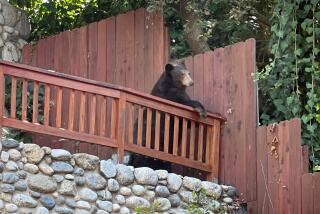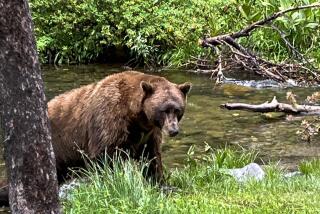Ursa Major : Noble and...
- Share via
From my house in Kenya it was 15 miles to a hillock where I saw a pride of six lions last year, four of them full-maned males. Lions are king, as they say. But as an American reared in the American West, the point I would like to make is that lions, grand as they are, are not king of my imagination and never will be. What evokes wonders of the wild like no other creature is the bear, noble and mystical.
Whether teddy bear or grizzly bear, they console us if our crowded world seems to be falling apart.
I carry with me a quote, passed along by a guide during one of my summers as a river boatman in the remote bear country of Alaska’s Brooks Range mountains. The author is unknown to me, although I wish she or he would step forward for the credit, because it is the most suggestive, and right, tribute to this animal I’ve read:
“In nature’s economy the grizzly holds a minor but favored place. In an industrial economy its place has become vanishingly small and surrounded by conflict. But in legend and story, in the mysterious landscapes of the human mind, the great bear has claimed an unassailable territory, and there it stands fast--symbol of untamed power. The power of a storm-swept, sunlit, lonely land. Symbol of a fierce indomitable courage. The presence of the great bears is the challenge of danger that lies at the heart of all wilderness. . . .”
The bear sharpens our senses.
Now we have before us two North American bear tales, both with intriguing inceptions. And both, regrettably, cause for complaint.
Rick Bass is a wiry former petroleum geologist who has made himself part of a colorful clique of Western environmental iconoclasts, a fraternity begot by the late Edward Abbey. They are successful because they convey from wildness three things: beauty, pleasure and meaning. And what more could one ask of life?
In his ninth book, Bass has all these ingredients, and we are prepared for a feast. His quest: Has a remnant population of grizzly bears survived in the San Juan Mountains of Colorado, despite generations of effort by humans to exterminate them? Let’s go find out. And not just by ourselves but in the company of Doug Peacock, America’s foremost 20th century mountain man, wildcat bear chronicler, friend of Abbey and the inspiration for Abbey’s memorable character, George Washington Hayduke, in “The Monkey Wrench Gang.”
A feast Bass does not deliver, however. His trips into the mountains are hurried, and “The Lost Grizzlies” has a hurried feel. Peacock, who is so far off-center that just the mention of him among environmentalists brings a warm smile, is rendered here, no doubt unintentionally, as a one-dimensionally profane, petulant and distant figure.
And the mythical grizzly of the San Juans? Somewhere in this book, the great bear is obscured by a neurotic fog of broken cars, rushed appointments, characters without character, all padded with tangents and random and strident rants against whatever pops into Bass’ mind--from grocery stores to virtual reality.
Abbey justified the nature of his nature writing this way: “to entertain my friends and exasperate our enemies.”
These things are within Bass’ ability. He has done them in the past. But not here. I doubt his friends will find this book entertaining. I wonder how “starry-eyed backpackers” will feel when they come under his lash? I’m afraid his enemies are more likely to be amused than his friends.
If Bass fails to meet expectations, Charles Russell delivers more than one might anticipate, which I say by way of both praise and objection.
His book “Spirit Bear” recounts two years filming a television documentary about an unusual cluster of bears--black bears, in fact--that are white in color as the result of a recessive gene, the so-called Kermode bears. At the time of Russell’s travels, up to 20 of these bears lived in the rain forest of an island off the British Columbia coast.
Russell has spent a lifetime among bears. His many color photographs are exceptional, and a few are profound. But after a quick session of soul-searching, the author goes beyond watching bears to befriending them, one in particular. He follows and takes naps with it, climbs in its den, “teaches” it some tricks about catching salmon in a stream, shields it from bigger bears, romps with it.
Maybe Russell is right: “Almost all of the disharmony that we humans have had with black bears, and probably to a large extent with grizzlies as well, over our long and troubled history together, might well be traced to mistakes and mistreatment of bears by humans, not the other way around.”
But I, for one, am uneasy. The white bears of Princess Royal Island are protected. Not so the black bears. What happens when a hunter, or a logger, or any other stranger with a .44 magnum walks the shore of this island only to see a ghostly white bear bounding out of the trees to “play?”
I would think, from the point of view of the bears, besieged, baited, tormented and trapped by humans in a thousand places for endless generations, the better lesson we friends can teach is how, first, to leave them alone to rule the wild.
More to Read
Sign up for The Wild
We’ll help you find the best places to hike, bike and run, as well as the perfect silent spots for meditation and yoga.
You may occasionally receive promotional content from the Los Angeles Times.






